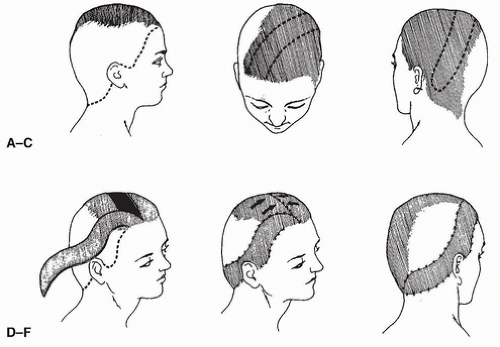Diagonal Frontoparieto-Occipital Scalp Flaps
J. JURI
EDITORIAL COMMENT
The oblique flap does not ensure the inclusion of a known arterial pedicle or a way to extend it beyond its known blood supply. Consequently, the need for increasing care and delays is clear.
ANATOMY
The diagonal frontoparieto-occipital scalp flap, which we call a diagonal flap, receives its blood supply from the frontal vessels. The area of convergence of the frontal branch of the superficial temporal artery and the supraorbital branches, because of their numerous connections with the contralateral vessels, allows the design of this flap across the midline (Fig. 5.1B and C). A second delay is performed at the end of the flap because of the perforating vessels in the occipital region.
 FIGURE 5.1 Schematic representation of the diagonal flap. A: Alopecia and frontal implant line. B,C: Flap design. D: Raising of the flap. E: Closure of the donor site and final suture of the flap. F: Posterior view of the flap in its final position. (From Juri et al., ref. 2, with permission.)
Stay updated, free articles. Join our Telegram channel
Full access? Get Clinical Tree
 Get Clinical Tree app for offline access
Get Clinical Tree app for offline access

|





